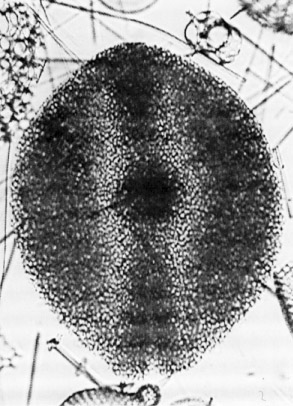 Spongaster
berminghami (Campbell and Clark)
Spongaster
berminghami (Campbell and Clark) Spongaster
berminghami (Campbell and Clark)
Spongaster
berminghami (Campbell and Clark)Spongasteriscus berminghami Campbell and Clark, 1944, p.30, pl.5, figs.1-2
Spongaster klingi Riedel and Sanfilippo, 1971, p.1589, pl.1D, figs.8-10, pl.4, figs.7-8
Spongaster berminghami (Campbell and Clark) Sanfilippo and Riedel, 1973, p.524; Riedel and Sanfilippo, 1978a, p.73, pl.2, figs.14-16
Shell of fair size, shaped like a Greek cross; with four arms in two opposite crossed pairs, two arms of one pair longer (vertical axis) than two arms of pair at an angle to them (transverse axis); arms squarish, wide (~0.83 length of longest arms, measured to center of shell, and about equal in length and width in transverse arms), free ends with rounded edges and subparallel sides, connected across angles made by intersection of paired arms by meshwork of similar structure and density, and not forming a patagium (quadrangular disc); meshwork made up everywhere of fine alveolelike, subhexagonal pores, very dense and frothy; framework with only a very few, short, widely scattered projecting points so that general surface is not spiny (Campbell and Clark, 1944).
Finely spongy skeleton elliptical in outline. Especially thickened are the central area, two opposite radii (and especially their distal parts), and two bluntly crescentic zones near the periphery (one on either side of the thickened diameter). One of the thickened radii includes a narrow conical pylome-tube (Riedel and Sanfilippo, 1971).
Length of long axis, 210-240 µm, of short axis, 140-180 µm (Campbell and Clark, 1944).
Major diameter 325-405 µm; minor diameter 255-355 µm (Riedel and Sanfi1ippo, 1971).
Major diameter of disk 270-405 µm; minor diameter 211-355 µm (Sanfilippo et al., 1985).
Elliptical spongy skeleton. Two opposite radii (especially their distal parts), and two bluntly crescentic zones near the periphery, are especially thickened and appear darker than the remainder of the skeleton (Riedel and Sanfilippo, 1978a).
The combination of thickened or denser areas on two opposite radii, and distinct crescentic areas at the periphery between those radii, distinguish S. berminghami from all other spongodiscids.
S. berminghami is an elliptical to sometimes circular, spongy disk with thickened or denser zones in the center and along two opposite radii, and in two crescent-shaped areas on the periphery between those radii. One of the thickened radii includes a narrow conical pylome-tube, in most specimens expressed at the margin as a small cleft. The thickened zones on opposite radii may appear as two discrete circular areas, or as a bar through the long axis, like a propeller (Sanfilippo et al., 1985).
S. berminghami is found in late late Miocene to early early Pliocene assemblages in latitudes lower than 40°, but it is rare in the Indian Ocean. Its morphotypic first appearance lies within the Didymocyrtis antepenultima Zone. Its evolutionary transition to Spongaster pentas defines the base of the Spongaster pentas Zone. However, its morphotypic last appearance is diachronous by ~0.8 m.y. (younger in the tropical Indian Ocean than in the tropical Pacific Ocean).
S. berminghami originated from a circular spongodiscid, and evolved into S. pentas.
For further discussion of the evolution of this species see Riedel and Sanfilippo, 1978a, p.88 and Riedel and Sanfilippo, 1981, pp.341-344.